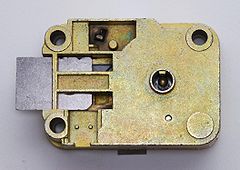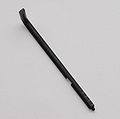La Gard 2200
La Gard 2200
| La Gard 2200 | |
 | |
| Name | La Gard 2200 |
|---|---|
| Manufacturer | La Gard |
| Lock Type | Safe lock |
| Lock Design | Disc-detainer |
| Specifications | |
| # of Components | 4 |
| Component Type | Disc-detainer |
The 2200 (or 2240, 2270) is a UL 768 Group 2 rated disc-detainer lock made by La Gard. It is one of the few rotating disc-detainer locks designed for use on safes. The 2200 is reyekable through the use of a change key similar to those used in combination safe locks. The 2200 series uses four disc-detainers and, unlike most other disc-detainer locks, does not use a sidebar. Instead, a lever and fence is used to interface with the gates on each disc.
Principles of operation
See also Disc-detainer (Principles of operation).
The 2200 functions very much like a traditional disc-detainer lock, but it incorporates a number of components commonly found in combination safe locks. It uses four disc-detainers and a lever/fence component. The rotation of the correct key aligns each disc's true gate under the fence. If all discs are correctly positioned, the fence can enter the true gates and the bolt can be retracted. Between each disc a plastic washer is placed to prevent adjacent discs from moving one another. Each disc uses a series of false gates to deter lockpicking attacks.
The 2200 also includes protections against common forms of destructive entry. Like many safe locks, the 2200 uses a relocker that triggers when the back cover plate is removed, usually through destructive attacks against the disc pack.
Key changing instructions
Unlike common disc-detainer locks, the 2200 is key-changeable using a reset key and a change key. The reset key is a zero-bitted normal key that is made of brass. The change key is similar to those used in mechanical combination safes.
The mark on the keyway escutcheon is referred to as the "Escutcheon Index". Associated marks on the reset key and working keys are referred to as the "Key Index".[1]
Setting the initial operating key
- Insert the reset key and turn clockwise to open the safe door.
- With the door open, turn the reset key counter-clockwise to extend the lock bolt.
- Turn the reset key clockwise slowly until the key index is aligned with the escutcheon index. The bolt should not be retracted.
- Insert the change key into the back of the lock and turn it clockwise until it stops.
- Turn the reset key counter-clockwise and remove it from the keyway.
- Insert the new working key and turn clockwise until the key index is aligned with the escutcheon index.
- Turn the change key counter-clockwise and remove it from the lock.
- Turn the new working key clockwise to ensure it can retract the bolt.
- Verify the new working key several times before closing and re-locking the safe.
To change the working key, follow these same instructions but substitute the reset key with the current working key.
Disassembly instructions
Like most safe locks, the 2200 is easy to disassemble. Make sure that each disc is returned in the same orientation when re-assembling the disc stack (discs cannot be flipped).
- Remove the screws from the back cover plate.
- Unscrew and remove the fence and fence spring.
- Remove the retaining clip from the disc pack.
- Remove the disc pack.
Notes
- Some models require the lever to be removed before the disc pack can be removed, others don't.
Vulnerabilities
The 2200 series may be vulnerable to one or more of the following:
Gallery
References
- ↑ KABA Operating Instructions www.manualslib.com








